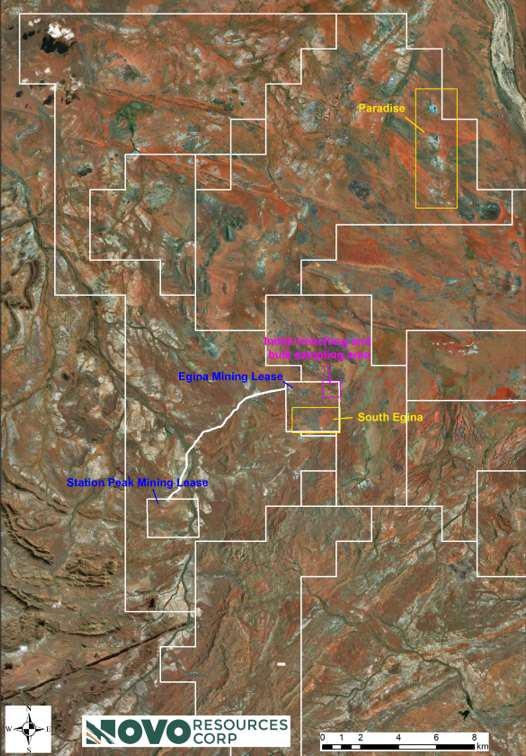Dec 18 2019
Novo Resources Corp. has reported that the latest exploration has unraveled wide-ranging new areas of gold-bearing terrace gravels at its Egina gold project, Pilbara, Australia.
 Map of the central part of the Egina mining area. The Egina mining lease, South Egina and Paradise targets are shown. Image Credit: Novo Resources Corp.
Map of the central part of the Egina mining area. The Egina mining lease, South Egina and Paradise targets are shown. Image Credit: Novo Resources Corp.
Heritage surveys, which were completed recently, offer access to several new target areas. Preliminary results from mechanical sorting test studies on Egina gravel bulk samples at Steinert Global have been highly encouraging.
Highlights
Fresh exploration work has confirmed the existence of vast areas of gold-bearing gravels at the Paradise and South Egina targets. Paradise is located about 14 km north-northeast and South Egina is located roughly 2 km south of the site of Novo’s latest trenching and bulk sampling work on the Egina mining lease.
Novo is very enthusiastic about early outcomes since these are the very first new target regions to be explored outside the main region of focus until now.
Novo has been employing prospect level trenching, “indicative” mini-bulk sampling, and metal detecting to evaluate productiveness of gravels in new target regions. Targets are Ground identified with the help of penetrating radar.
Gold nuggets have been identified and gold of finer grains has been extracted by processing mini-bulk samples from several pits at both Paradise and South Egina. Paradise and South Egina are the first two of the multiple new target regions Novo intends to investigate over the next few months.
If weather permits, Novo has planned to focus a majority of the field activities on exploring to find more gold-bearing gravel regions in summer months from now until April 2020. The aim of this exploration will be to characterize at least five new high-potential regions of gold-bearing gravels on which similar systematic trenching and bulk sampling can be performed, as those carried out at the Egina mining lease in the last few months.
Novo believes several new areas can be identified, which can prospectively be developed into larger bulk sampling sites.
Recently, two large—circa 600 cubic meter—bulk samples were gathered from the targeted “swale” at the Egina mining lease. At present, these samples are being processed at Novo’s IGR3000 gravity gold plant. The results will enable Novo to compare them with 30–80 cubic meter bulk samples processed earlier. Results from these are expected to be available in Quarter 1 of 2020.
Recently, Kariyarra Aboriginal Corporation finished another heritage survey, in which Novo covered target areas over tenements E47/2502, E47/3318, and M47/561. In total, about 20 km2 of high-priority, potential gravel target areas have now been heritage surveyed and are accessible for exploration inside the greater Egina Project area.
Roughly 0.43 km2 of the surveyed area includes heritage sites that will be managed in compliance with the KAC direction.
Additional heritage surveys to enlarge the area accessible for ground-disturbing exploration work will be solicited from KAC in the new year. Novo acknowledges with gratitude the Kariyarra People for advancing these heritage surveys and offering the Company with the understanding needed to make sure that heritage values are safeguarded on the ground from where Novo operates.
Recently, a roughly 5-ton Egina gravel bulk sample was screened into three size fractions, less than 6 mm, 6–18 mm, and 18–50 mm. The sample then underwent mechanical sorting tests at Steinert Global’s Perth test facility. Each size fraction was first seeded with nuggets that were commensurately sized. Then, for comparison, the size fractions were photographed prior to and following each trial.
Repeated tests showed 100% effective recovery of all gold particles with a size of more than 1 mm into concentrates of much less than 1% of the total mass, which is a fascinating result. It is necessary to use analytic methods to evaluate the recovery of very small gold particles measuring less than 1 mm because these grains are too small to differentiate from concentrates by the naked eye.
Early next year, further analyses will be carried out, and at that point, Novo can submit further comments related to the final rate of gold recovery. An evaluation of the lower limit of gold particle size that can be mechanically sorted will also be feasible as soon as the results of analyses are obtained.
Recent exploration and mechanical sorting success at Egina have capped a very good year for this exciting gold project. We recently commenced broad scale exploration activities with the aim of identifying at least five new areas of highly prospective gold-bearing gravels.
Quinton Hennigh, President and Chairman, Novo Resources Corp.
Hennigh continued, “Our first two targets, South Egina and Paradise, have yielded early, but very promising indications of appreciable gold in terrace gravels. With recent heritage surveys now complete, we are in an excellent position to test yet further targets over the next few months.”
On top of these critical advancements in exploration, our initial results from mechanical sorting tests of Egina gravels show excellent promise for high recovery of gold into very small mass concentrates. Given most Egina gold appears to be of size that can be sorted, such processing will likely prove the critical advancement that unlocks this vast gold project.
Quinton Hennigh, President and Chairman, Novo Resources Corp.